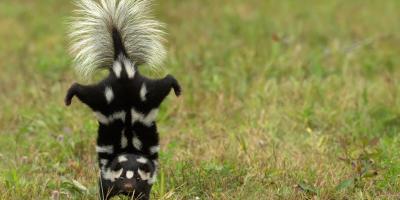Time to Evict the Flighty Tenants

New England is once again seeing an abundance of mast spread across the forest floor; including acorns from oak trees and their close arboreal relatives. These indigenous tree nuts are a valuable food source for a plethora of wildlife, most notably rodents – which includes our three local squirrel species: gray, red and flying. With high food abundance comes increased health and breeding. As a result, wildlife professionals throughout the region are observing early indicators of a high mouse and squirrel presence this winter in and around human dwellings. Meanwhile, one species in particular has carved out a niche for making use of human structures: the flying squirrel.
Three species of flying squirrels are found throughout North America, two of which are New England natives. The animal’s nocturnal behavior makes them commonly cryptic to many homeowners, which are traditionally more familiar with their daytime cousins – the red squirrel and their larger, invasive relative: the gray squirrel. The flying squirrel’s common name is derived from the animal’s ability to glide through the air using a membrane called a patagium: a square fold of skin connecting the forearms to the hind legs. From a running start, these squirrels are able to propel themselves off a tree or other elevated surface and–once airbound–are able to use their patagia together as a provisional parachute, prompting an air-ridden “glide ride” at angles of 30 to 40 degrees, while effortlessly making sharp turns to dodge obstacles. Just before reaching a tree (or the roof of your home), the animal will raise their flattened tail to abruptly change trajectory for a flawless landing. Despite the name, flying squirrels are not actually capable of flight.

The northern and southern flying squirrels, differing slightly from each other in fur color and size, are both readily found in the forests of New England. Prone to nesting in hollow trees, flying squirrels become a nuisance when they manipulate small and subtle structure voids around the roof systems of structures. The attics and wall voids of our homes are a common attractant when the opportunity for such harborage presents itself, as these areas can commonly mimic that of tree hollows. Homes encompassed in tree canopy immediately around the structure are particularly vulnerable, as trees in close proximity to the roofline allow a “jumping-off” point for flyers to access the roof system from above. Once inside, insulation is balled into a nest for harborage. Flying squirrels are typically not alone for long once they’ve gained access to the home, as shared nests may house up to eight or more adults and juveniles. Even solitary individuals will gather into groups, particularly during the winter months.
Once inside, flying squirrels will typically choose an area of their nesting space for waste and defecation, known as a “latrine”. This area tends to be a common indicator of a flying squirrel infestation, as urine leeches from walls and ceilings, leaving visible staining. In the event that a latrine is not visibly present (yet), their audible clues are not easily missed; shifting or scurrying in walls and ceilings, coupled with the squirrel’s audible chirp, tend to become noticeable to occupants. Occasionally, squirrels will inadvertently find themselves trapped in living spaces of the home while exploring their new nesting areas – and they are often mistaken for chipmunks and mice, since these squirrels look much more like these animals than their other, more closely-related squirrel cousins. The flying squirrel’s large black eyes (utilized for nocturnal night vision) are a dead giveaway characteristic differentiating them from other species.
Regardless of the species, rodents of any kind should not be welcome in your home. The havoc they wreak with their presence does not stop with loud noises from overhead: Flying squirrels are infamous for their ability to cause damage to a home’s structure, insulation, electrical wiring, and any other items stored within their reach. Meanwhile, their presence also creates a health hazard for the people living within the home, as the latrine will become more saturated with urine and droppings the longer the animals are allowed to use it. This is why JP Pest Services promotes quick, effective, and humane exclusion methods. Your home and safety is our priority, and the safety of the animal is a very close second.



